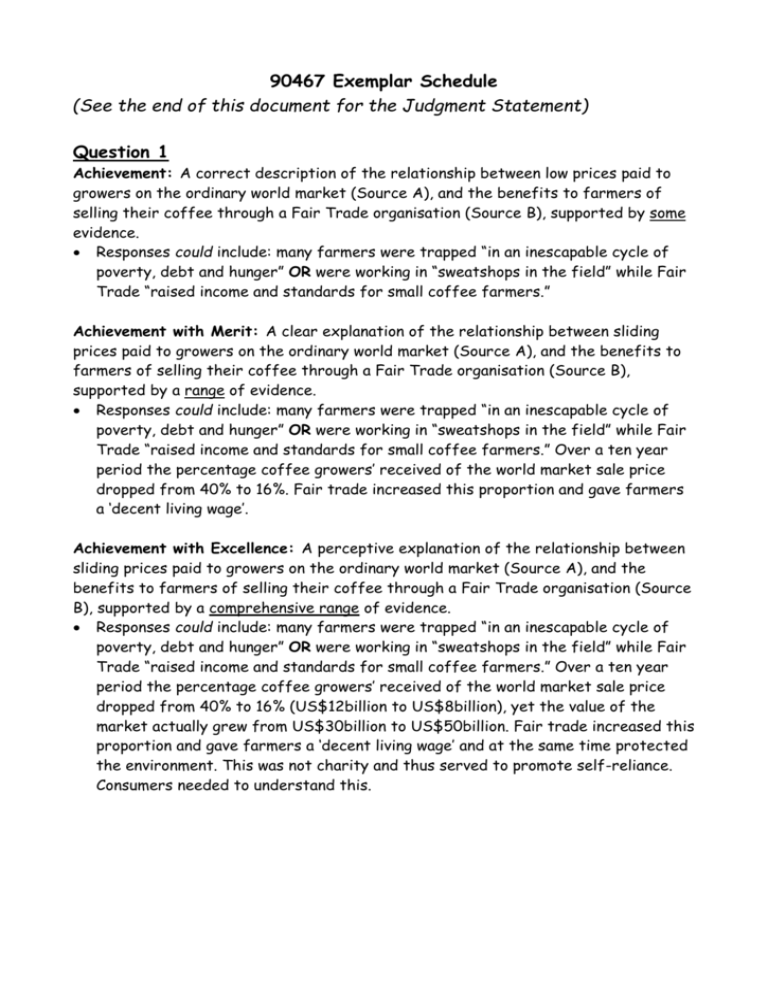90467 Schedule - Northcote
advertisement

90467 Exemplar Schedule (See the end of this document for the Judgment Statement) Question 1 Achievement: A correct description of the relationship between low prices paid to growers on the ordinary world market (Source A), and the benefits to farmers of selling their coffee through a Fair Trade organisation (Source B), supported by some evidence. Responses could include: many farmers were trapped “in an inescapable cycle of poverty, debt and hunger” OR were working in “sweatshops in the field” while Fair Trade “raised income and standards for small coffee farmers.” Achievement with Merit: A clear explanation of the relationship between sliding prices paid to growers on the ordinary world market (Source A), and the benefits to farmers of selling their coffee through a Fair Trade organisation (Source B), supported by a range of evidence. Responses could include: many farmers were trapped “in an inescapable cycle of poverty, debt and hunger” OR were working in “sweatshops in the field” while Fair Trade “raised income and standards for small coffee farmers.” Over a ten year period the percentage coffee growers’ received of the world market sale price dropped from 40% to 16%. Fair trade increased this proportion and gave farmers a ‘decent living wage’. Achievement with Excellence: A perceptive explanation of the relationship between sliding prices paid to growers on the ordinary world market (Source A), and the benefits to farmers of selling their coffee through a Fair Trade organisation (Source B), supported by a comprehensive range of evidence. Responses could include: many farmers were trapped “in an inescapable cycle of poverty, debt and hunger” OR were working in “sweatshops in the field” while Fair Trade “raised income and standards for small coffee farmers.” Over a ten year period the percentage coffee growers’ received of the world market sale price dropped from 40% to 16% (US$12billion to US$8billion), yet the value of the market actually grew from US$30billion to US$50billion. Fair trade increased this proportion and gave farmers a ‘decent living wage’ and at the same time protected the environment. This was not charity and thus served to promote self-reliance. Consumers needed to understand this. Question 2 Achievement: A correct description of the historical relationship of past (Source C) and present (Source B) is given, supported by some evidence. Responses could include at least one of: Coffee is still an important economic resource (Brazil’s economy built on it/small farmers dependent on it for income); vulnerability of small farmers (banks and trading houses profited at small farmers’ expense in Brazil/Fair Trade ensures a fair price is paid and raises incomes); ecological impact of coffee growing (Parahyba Valley/Fair Trade’s environmental standards); labour exploitation (slavery in Brazil/organisations such as Fair Trade exist to protect workers and small growers from exploitation). Achievement with Merit: A clear explanation of the historical relationship of past (Source C) and present (Source B) is given, supported by a range of evidence. Responses could include at least one of: Coffee is still an important economic resource (Brazil’s economic and social structure built on it/small farmers dependent on it for income, avoiding the need for charity); vulnerability of small farmers (banks and trading houses profited at small farmers’ expense in Brazil/Fair Trade ensures a fair price is paid and raises incomes, while developing sustainability); ecological impact of coffee growing (Parahyba Valley deforested/Fair Trade’s environmental standards part of its policy); labour exploitation (slavery in Brazil, although fundamental to the industry’s development, meant misery for many/organisations such as Fair Trade exist to protect workers and small growers from exploitation, and provides links between buyers and farmers). Achievement with Excellent: A perceptive explanation of the historical relationship of past (Source C) and present (Source B) is given, supported by a comprehensive range of evidence. Responses could include at least one of: Coffee is still an important economic resource (Brazil’s economic and social structure built on it, using slaves and investment by international companies/small farmers dependent on it for income, avoiding the need for charity and promoting economically sustainable self-reliance on an equitable basis); vulnerability of small farmers (international banks and trading houses in London and New York profited at small farmers’ expense in Brazil, where small farmers were often impoverished/Fair Trade ensures – via inspections - a fair price is paid and raises family incomes, while developing sustainability); ecological impact of coffee growing (Parahyba Valley deforested within a century/Fair Trade’s environmental standards part of its policy); labour exploitation (slavery in Brazil, although fundamental to the industry’s development, meant misery for many, yet the industry continued even after its abolition/organisations such as Fair Trade exist to protect workers and small growers from exploitation, and provides links between buyers and farmers, while also promoting social justice such as women’s participation and democratic representation). Question 3 Achievement: A correct description of the reliability or not of the views about worker conditions in Source D is given, supported by some evidence. Responses should provide valid comments on both Sources, and could include: Reliable: although Source A talks about the poor conditions and prices for growers, Source D is by a grower who started as a worker and has tried to improve conditions. Unreliable: Source A talks about the drop in prices paid to growers and how this has created ‘sweatshops in the field’ or even slavery. It would be hard for the grower in Source D to stand up to the big companies OR the workers might not agree with the grower’s rosy view. Achievement with Merit: A clear explanation of the reliability or not of the views about worker conditions in Source D is given, supported by a range of evidence. Responses should provide valid comments on both Sources, and could include: Reliable: although Source A talks about the poor conditions and prices for growers, Source D is by a grower who started as a worker and has tried to improve conditions. He says “Trust, honesty, hard work and teamwork are important building blocks for a strong future." The grower in Source D might be a member of Fair Trade, Source B, and his views are in line with the organisation’s policies, such as providing a decent wage. Unreliable: Source A talks about the drop in prices paid to growers and how this has created ‘sweatshops in the field’ or even slavery. It would be hard for the grower in Source D to stand up to the big companies OR the workers might not agree with the grower’s rosy view. Not all growers are part of Fair Trade, Source B, as it is more profitable for them to exploit their workers. Achievement with Excellence: A perceptive explanation of the reliability or not of the views about worker conditions in Source D is given, supported by a comprehensive range of evidence. Responses should provide valid comments on both Sources, and could include: Reliable: although Source A talks about the poor conditions and prices for growers (their ‘cut’ dropping from 40% to 16% over a ten year period), Source D is by a third-generation grower who started as a worker and who has tried to improve his own workers’ conditions. He provides verifiable details of improvements for workers (eg medical, dental, eye care), not just generalisations. He says “Trust, honesty, hard work and teamwork are important building blocks for a strong future." The grower in Source D might have succeeded because he was/is a member of Fair Trade, Source B. His views are in line with the organisation’s policies, such as providing a decent wage and good conditions. Unreliable: Source A talks about the drop in prices paid to growers (their ‘cut’ dropping from 40% to 16% over a ten year period, despite the industry’s value increasing from US$30billion to US$50billion) and how this has created ‘sweatshops in the field’ or even slavery. It would be hard for the grower in Source D to stand up to the big companies OR the workers might not agree with the grower’s rosy view; we don’t hear anything from them. Not all growers are part of Fair Trade, Source B, as it is more profitable for them to exploit their workers, as the figures above attest. The fact that Fair Trade exists at all suggests that exploitation is far more common than not, and that growers might feel under some pressure to appear to provide well for their workers. Question 4 Achievement: A correct description of the usefulness of the Sources for the study of the social and/or political role of coffee houses is given, supported by some evidence. Responses should provide valid comments on at least TWO of the Sources, and could include: Source E1 gives a general overview and talks about revolutionaries in France and America meeting in coffee houses. In Source E2 the King tried to ban coffee houses because ‘trouble-makers’ used them and disturbed the ‘peace and quiet of his kingdom’. In Source E3 it says that coffee bars filled a ‘social gap’. Achievement with Merit: A clear explanation of the usefulness of the Sources for the study of the social and/or political role of coffee houses is given, supported by a range of evidence. Responses should provide valid comments on all THREE of the Sources, and could include: Source E1 gives a general overview and talks about revolutionaries in France and America meeting in coffee houses. In Source E2 the King tried to ban coffee houses because ‘trouble-makers’ disturbed the ‘peace and quiet of his kingdom’; this is especially useful as it is a primary source. In Source E3 it says that coffee bars filled a ‘social gap’ and changed NZers’ lifestyles. It also gives a good description of Wellington’s social life ‘before’ and ‘after’ coffee bars. The three Sources together help show the role of coffee houses over different places and times. Achievement with Excellence: A perceptive explanation of the usefulness of the Sources for the study of the social and/or political role of coffee houses is given, supported by a comprehensive range of evidence. Responses should provide valid comments on all THREE of the Sources, and could include: Source E1 gives a general overview and talks about revolutionaries in France and America meeting in coffee houses. In Source E2 the English King tried to ban coffee houses because ‘trouble-makers’ used them to spread many ‘false, hateful and scandalous rumours’ and disturbed the ‘peace and quiet of his kingdom’; this is especially useful as it is a primary source. In Source E3 it says that coffee bars filled a ‘social gap’ and changed NZers’ lifestyles. Harry Seresin's coffee house was one such place, a ‘focal point for writers, poets, artists, musicians and academics’. It gives a good description of Wellington’s social life ‘before’ (tea-rooms, closed in the afternoon; pubs, male-only and closed at 6pm; restaurants, closed by 10pm and unable to serve liquor) and ‘after’ coffee bars (open during the day and evening, through to the early hours). The three Sources together help show the role of coffee houses over different places and times, and that they were often places where social/political non-conformists gathered. Question 5 Achievement: A correct description of the relationship of continuity OR change between the price paid to growers of coffee and the price retailers charged their customers, 1970-2000, supported by evidence. NOTE: responses may argue either position as long as they are supported by appropriate some evidence. Responses could include: o Continuity – growers were always paid substantially less than retailers charged their customers – 600cents per pound versus 100cents per pound in 1970; 450cents per pound versus 50cents per pound in 2000. o Change – there were some big variations over the period – eg 600cents per pound versus 100cents per pound in 1970; 1300cents per pound versus 300cents per pound in the late 1970s. Achievement with Merit: A clear explanation of the relationship of continuity OR change between the price paid to growers of coffee and the price retailers charged their customers, 1970-2000, supported by a range of evidence. Responses could include: o Continuity – the difference between what growers were paid and retailers charged their customers remains fairly constant over the period as a whole, despite some spikes – 600cents per pound versus 100cents per pound in 1970 (500cents difference); 450cents per pound versus 50cents per pound in 2000 (400cents difference). o Change – there were some big variations over the period – eg 600cents per pound versus 100cents per pound in 1970; 1300cents per pound versus 300cents per pound in the late 1970s OR prices both groups received have declined over the whole period - 600cents per pound per pound in 1970 versus 450cents per pound in 2000 for retailers; 100cents per pound in 1970 versus 50cents per pound in 2000 for growers. Achievement with Excellence: A perceptive explanation of the relationship of continuity OR change between the price paid to growers of coffee and the price retailers charged their customers, 1970-2000, supported by a comprehensive range of evidence. Responses could include: o Continuity – the difference between what growers were paid and retailers charged their customers remains fairly constant over the period as a whole, despite some spikes – 600cents per pound versus 100cents per pound in 1970 (500cents difference); 450cents per pound versus 50cents per pound in 2000 (400cents difference). For all of the spikes retailers benefited more than growers, but both groups benefited; growers’ prices were, overall, more stable. o Change – there were some big variations over the period, with retailers enjoying the highest spikes but also the biggest falls – eg 600cents per pound versus 100cents per pound in 1970; 1300cents per pound versus 300cents per pound in the late 1970s OR prices both groups received have declined over the whole period - 600cents per pound per pound in 1970 versus 450cents per pound in 2000 for retailers; 100cents per pound in 1970 versus 50cents per pound in 2000 for growers. Judgement Statement Achieved Students will necessarily meet the requirements of this criterion by completing the criteria below, as per the descriptor. The historical relationships in two out of the three questions (1, 2, 5) are described (with some supporting evidence). Merit Students will necessarily meet the requirements of this criterion by completing the criteria below, as per the descriptor. The historical relationships in two out of the three questions (1, 2, 5) are explained (with a range of supporting evidence). The usefulness/reliability in one out of the two questions (3, 4) is described (with some supporting evidence). The usefulness/reliability in one out of the two questions (3, 4) is explained (with a range of supporting evidence). Excellence Students will necessarily meet the requirements of this criterion by completing the criteria below, as per the descriptor. The historical relationships in two out of the three questions (1, 2, 5) are perceptively explained (with a comprehensive range of supporting evidence). The usefulness/reliability in one out of the two questions (3, 4) is perceptively explained (with a comprehensive range of supporting evidence).


![저기요[jeo-gi-yo] - WordPress.com](http://s2.studylib.net/store/data/005572742_1-676dcc06fe6d6aaa8f3ba5da35df9fe7-300x300.png)




